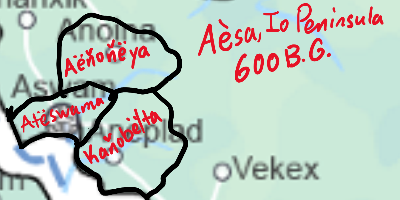Late Classical Iopon (1 janv. 200 – 1 janv. 350)
Description:
Sound changes between Classical Iopon to Late Classical Iopon:Dipthongs often monophthongize - /eɪ̯/ > /eː/ or /iː/; /ɑɪ̯/ > /ɛː/ or /eː/; /oɪ̯/ > /oː/ or /œ/; /uɪ̯/ > /yː/ or /uː/
Voiced stops and fricatives at word-final position become voiceless
/b, d, g/ > /p, t, k/
Voiced consonants assimilate to neighboring voiceless sounds:
/ɣt/ > /xt/ or /χt/; /dz/ > /ʦ/
Unstressed middle syllables are dropped or reduced to schwa:
(This is to reduce spoken effort primarily for rapid speech)
(/CV.CV.CV/ > /CV.CV/ or /CVː/
Palatization before front vowels (before /i, e/):
/k, g/ > /ʧ, ʤ/
/t, d/ > /tʲ, dʲ/ or /sʲ, zʲ/ or /ʧʲ/
Glottal stops /ʔ/ are lost, often lengthening adjacent vowels
Consonant clusters like /kt, ps, xt/ become simplified:
Cake /heɪ̯xun/ > /hɛːn/
Cannibal /tɪsɑⁿtok/ > /ʦɑⁿt/
Voiceless stops between vowels often become fricatives or affricatives:
/t/ > /θ/, /s/, /ʦ/
/d/ > /ð/ or /z/
Exe. To cook /tesa/ > /θesɑ/
Nasal + stop sequences often assimilate:
/nt, mp/ > /n, t/, /m, b/
Nasals may weaken or drop before fricatives:
/ns/ > /s, ʦ/; /nz/ > /z,ʦ/
Fixed stress position may shift to initial or penultimate syllable caausing reanalysis of word boundaries and suffixes
Exe. (to) that = /ˈsɪltɑs/ > /ˈsɪl.təs/ > /ˌsəl.ˈtɑs/; We = /ˌɛˈsiˌɣɑ/ > /ˈes.ɪ.ˌxɑ/ > /ˈes.xɑ/
Ajouté au bande de temps:
Date:
1 janv. 200
1 janv. 350
~ 150 years
